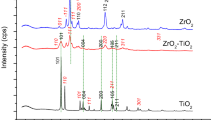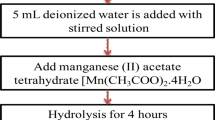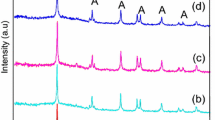Abstract
Transition metal-doping could effectively extend the light response range of TiO2 photocatalysts from the ultraviolet (UV) to the visible region. Co-doped brookite titanium dioxide (Co–TiO2) photocatalysts were synthesized via the hydrothermal method with titanium tetrachloride as the raw material and cobalt chloride hexahydrate as the dopant. The prepared Co–TiO2 photocatalysts were characterized by X-ray diffraction (XRD), scanning electron microscopy (SEM), transmission electron microscopy (TEM), Raman spectroscopy, X-ray photoelectron spectroscopy (XPS) and UV–Vis diffuse reflectance spectroscopy (UV–Vis DRS). The photocatalytic activities of Co–TiO2 photocatalysts were evaluated by photocatalytic degradation of isopropanol alcohol (IPA), a typical volatile organic compound (VOC), under visible light. The influences of different Co doping rates, initial concentrations of IPA gas and the amounts of photocatalyst addition were also studied. At the same time, the enhancement mechanism of cobalt ions as a trap for photogenerated holes was discussed. Thus, we found the optimum doping rate, initial concentration of IPA gas and amount of photocatalyst to add. The results show that the mesoporous Co–TiO2 photocatalysts possess smaller size particles, larger specific surface area, lower forbidden bandgap energy (Eg) and better photocatalytic activity than pure brookite TiO2. When the doping of Co was 7% by mass, the initial concentration of IPA gas was 1.0 × 10−6 mol/L and the addition of Co–TiO2 photocatalysts was 50 mg, the best photocatalytic activity was achieved. Furthermore, the degradation rate of IPA was up to 91%, which shows great potential for waste water treatment.











Similar content being viewed by others
References
Adán C, Bahamonde A, Fernández-García M et al (2007) Structure and activity of nanosized iron-doped anatase TiO2 catalysts for phenol photocatalytic degradation. Appl Catal B 72(1–2):11–17
Burda C, Lou Y, Chen X et al (2003) Enhanced nitrogen doping in TiO2 nanoparticles. Nano Lett 3(8):1049–1051
Hosseini SN, Borghei SM, Vossoughi M et al (2007) Immobilization of TiO2 on perlite granules for photocatalytic degradation of phenol. Appl Catal B 74(1):53–62
Li D, Haneda H, Hishita S et al (2005) Visible-light-driven NF-codoped TiO2 photocatalysts. 1. Synthesis by spray pyrolysis and surface characterization. Chem Mater 17(10):2588–2595
Saquib M, Muneer M (2003) TiO2 mediated photocatalytic degradation of a triphenylmethane dye (gentian violet) in aqueous suspensions. Dyes Pigm 56(1):37–49
Wang J, Uma S, Klabunde KJ (2004) Visible light photocatalysis in transition metal incorporated titania-silica aerogels. Appl Catal B 48(2):151–154
Kang W, Spanjers CS, Rioux RM et al (2013) Synthesis of brookite TiO2 nanorods with isolated Co(ii) surface sites and photocatalytic degradation of 5, 8-dihydroxy-1, 4-naphthoquinone dye. J Mater Chem A 1(26):7717–7728
Lin H, Li L, Zhao M et al (2012) Synthesis of high-quality brookite TiO2 single-crystalline nanosheets with specific facets exposed: tuning catalysts from inert to highly reactive. J Am Chem Soc 134(20):8328–8331
Liao Y, Que W, Jia Q et al (2012) Controllable synthesis of brookite/anatase/rutile TiO2 nanocomposites and single-crystalline rutile nanorods array. J Mater Chem 22(16):7937–7944
Shibata T, Irie H, Ohmori M et al (2004) Comparison of photochemical properties of brookite and anatase TiO2 films. Phys Chem Chem Phys 6(6):1359–1362
Sun P, Liu L, Cui SC et al (2014) Synthesis, characterization of Ce-doped TiO2 nanotubes with high visible light photocatalytic activity. Catal Lett 144(12):2107–2113
Khalid NR, Ahmed E, Hong Z et al (2013) Cu-doped TiO2 nanoparticles/graphene composites for efficient visible-light photocatalysis. Ceram Int 39(6):7107–7113
Pang YL, Abdullah AZ (2012) Effect of low Fe3+ doping on characteristics, sonocatalytic activity and reusability of TiO2 nanotubes catalysts for removal of Rhodamine B from water. J Hazard Mater 235(2):326–335
Deng L, Wang S, Liu D et al (2009) Synthesis, characterization of Fe-doped TiO2 nanotubes with high photocatalytic activity. Catal Lett 129(3/4):513–518
Zhao HM, Chen Y, Quan X et al (2007) Preparation of Zn-doped TiO2 nanotubes electrode and its application in pentachlorophenol photoelectrocatalytic degradation. Chin Sci Bull 52(11):1456–1461
Umebayashi T, Yamaki T, Itoh H et al (2002) Analysis of electronic structures of 3d transition metal-doped TiO2 based on band calculations. J Phys Chem Solids 63(10):1909–1920
Stoyanova AM, Hitkova HY, Ivanova NK et al (2013) Photocatalytic and antibacterial activity of Fe-doped TiO2 nanoparticles prepared by nonhydrolytic sol-gel method. Bul Chem Commun 45(4):497–504
Paola AD, Ikeda S, Marcì G et al (2001) Transition metal doped TiO2: physical properties and photocatalytic behaviour. Int J Photoenergy 3(4):171–176
Ghasemi S, Rahimnejad S, Setayesh SR et al (2009) Transition metal ions effect on the properties and photocatalytic activity of nanocrystalline TiO2 prepared in an ionic liquid. J Hazard Mater 172(2):1573–1578
Karakitsou KE, Verykios XE (1993) Effects of altervalent cation doping of titania on its performance as a photocatalyst for water cleavage. J Phys Chem 97(6):1184–1189
Zhu J, Zheng W, He B et al (2004) Characterization of Fe–TiO2 photocatalysts synthesized by hydrothermal method and their photocatalytic reactivity for photodegradation of XRG dye diluted in water. J Mol Catal A 216(1):35–43
Lü XM, Liu J, Zhang H et al (2009) Structure and property of mesoporous molybdenum/carbon co-doped brookite titania. Trans Nonferrous Met Soc China 19(Suppl 3):669–673
He C, Yu Y, Hu X et al (2002) Influence of silver doping on the photocatalytic activity of titania films. Appl Surf Sci 200(1):239–247
Eshaghi A, Eshaghi A (2011) Optical and hydrophilic properties of nanostructure Cu loaded brookite TiO2 thin film. Thin Solid Films 520(3):1053–1056
Eshaghi A, Eshaghi A (2011) Preparation and hydrophilicity of TiO2 sol–gel derived nanocomposite films modified with copper loaded TiO2 nanoparticles. Mater Res Bull 46(12):2342–2345
Moradi H, Eshaghi A, Hosseini SR et al (2016) Fabrication of Fe-doped TiO2 nanoparticles and investigation of photocatalytic decolorization of reactive red 198 under visible light irradiation. Ultrason Sonochem 32:314–319
Shen P, Cao JL, Leng WH et al (2003) Preparation, microstructure and photoelectrochemical properties of Co doped titanium oxide electrodes. Chin J Chem Phys 16(4):307–311
Eshaghi A, Eshaghi A (2012) Optical and hydrophilic properties of Cr doped TiO2–SiO2 nanostructure thin film. Appl Surf Sci 258(7):2464–2467
Asgharinezhad M, Eshaghi A, Arab A (2016) Fabrication and characterization of optical and electrical properties of vanadium doped titanium dioxide nanostructured thin film. Opt Int J Light Electron Opt 127(19):8130–8134
Stranak V, Quaas M, Bogdanowicz R et al (2010) Effect of nitrogen doping on TiO x N y thin film formation at reactive high-power pulsed magnetron sputtering. J Phys D Appl Phys 43(28):285203
Meng X, Wang D, Liu J et al (2004) Preparation and characterization of sodium titanate nanowires from brookite nanocrystallites. Mater Res Bull 39(14/15):2163–2170
Mo D, Ye DQ (2009) Surface study of composite photocatalyst based on plasma modified activated carbon fibers with TiO2. Surf Coat Technol 203(9):1154–1160
Jensen H, Soloviev A, Li Z et al (2005) XPS and FTIR investigation of the surface properties of different prepared titania nano-powders. Appl Surf Sci 246(1):239–249
Li JG, Büchel R, Isobe M et al (2009) Cobalt-doped TiO2 nanocrystallites: radio-frequency thermal plasma processing, phase structure, and magnetic properties. J Phys Chem C 113(19):8009–8015
Choudhury B, Choudhury A, Islam AKMM et al (2011) Effect of oxygen vacancy and dopant concentration on the magnetic properties of high spin Co2+ doped TiO2 nanoparticles. J Magn Magn Mater 323(5):440–446
Lin YB, Yang YM, Zhuang B et al (2008) Ferromagnetism of Co-doped TiO2 films prepared by plasma enhanced chemical vapour deposition (PECVD) method. J Phys D Appl Phys 41(19):195007
Yan S, Huang QD, Lin JD et al (2011) Photocatalytic activity of cobalt doped titania for H2 evolution. Acta Phys Chim Sin 27(10):2406–2410
Dvoranova D, Brezova V, Mazúr M et al (2002) Investigations of metal-doped titanium dioxide photocatalysts. Appl Catal B 37(2):91–105
Wu S, Ma Z, Qin YN et al (2004) Photocatalytic redox activity of doped nanocrystalline TiO2. Acta Phys Chim Sin 20(2):138–143
Kudo A, Miseki Y (2009) Heterogeneous photocatalyst materials for water splitting. Chem Soc Rev 38(1):253–278
Ni M, Leung MKH, Leung DYC et al (2007) A review and recent developments in photocatalytic water-splitting using TiO2 for hydrogen production. Renew Sustain Energy Rev 11(3):401–425
Acknowledgements
This work was supported by the National Key Basic Research and Development Program of China (“973” program, nos. 2012CB720100 and 2014CB239300), the National Natural Science Foundation of China (nos. 21406164 and 21466035), the Science and Technology Innovation Guide Funds of Civil Aviation Administration of China (MHRD20140209), and the Fundamental Research Funds for the Central Universities (no. 3122016L016).
Author information
Authors and Affiliations
Corresponding author
Rights and permissions
About this article
Cite this article
Tan, X., Huang, X., Zou, Y. et al. Synthesis and Characterization of Co-Doped Brookite Titania Photocatalysts with High Photocatalytic Activity. Trans. Tianjin Univ. 24, 111–122 (2018). https://doi.org/10.1007/s12209-017-0103-9
Received:
Revised:
Accepted:
Published:
Issue Date:
DOI: https://doi.org/10.1007/s12209-017-0103-9




